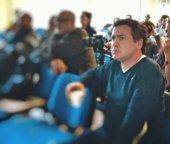Radio Mundo Real
http://radiomundoreal.fm/9352-pablo-galeano-redes-foe-at-the
5 de octubre de 2016 | Noticias | Seminario Regional 20 años de Transgénicos en Uruguay | Anti-neoliberalismo | Derechos humanos | Soberanía Alimentaria

Pablo Galeano (Redes-FoE) at the Seminar “20 Years of GMOs in Uruguay”
October 2nd marked the 20th anniversary of the authorization of the first GM crop in Uruguay. As an assessment of the regional situation, REDES-Friends of the Earth Uruguay organized in Montevideo a meeting for researchers, farmers and environmental activists. Several regional experts shared their views about the consequences of having coexisted for over two decades with these biotechnology products and their related agrotoxics.
One of these experts was Pablo Galeano, biochemist and professor at the Chemistry School of the University of the Republic. Galeano has studied transgene flows in maize crops, which is also known as “genetic contamination” or “involuntary crossbreeding”, which has been detrimental for many native maize farmers.
He is member of REDES-Friends of the Earth Uruguay and the National Coordination of the Native Seeds Network. At the Seminar, Galeano started his intervention by reviewing the document that authorized that first GM crop in 1996.
The introduction of GMOs in the region started in 1996 with authorizations in Argentina and Uruguay for RR soy, a crop resistant to glyphosate, owned by Monsanto. In both cases, the authorizations were not preceded by environmental impact assessments or socio-economic studies. From Argentina and Uruguay, GM soy was illegally introduced in Brazil, Paraguay and Bolivia. The governments, instead of controlling and applying penalties to those who illegally introduced these crops in their countries, adapted their regulations in order to allow for them.
When in 1996, Uruguay authorized the first commercial release of a GM crop, the country didn´t have a specific regulatory framework for the introduction of genetically modified plant organisms. The Agricultural Protection Services Directorate of the Livestock, Agriculture and Fisheries Ministry (MGAP) authorized RR soy (tolerant to glyphosate and developed by Monsanto under the commercial name of Roundup) without conducting risk assessments or applying biosafety measures.
In 2000, the Cartagena Protocol on biosafety established that: The goal of the risk assessment is to “identify and evaluate the possible adverse effects of living modified organisms on the conservation and sustainable use of biological diversity, taking also into account risks to human health”.
But by then, Uruguay had already authorized the release of the first GM crop without assessing its potential adverse effects.
In 2006, the National Biosafety Framework Development Project on GMOs in Uruguay of the National Environmental Directorate, the UNEP and GEF warned that “risk management in situations of contained use of GMOs does not present difficulties, since there are well-established methods and procedures to ensure a general safety system in the labs. But with non-contained uses, that include the release of GMOs to the environment, the potential risks and benefits generated by the use of these organisms should be analyzed on a “case by case basis”, with a solid scientific basis and taking into account, for each GMO in particular, the genetic modification in question; the environment where it is intended to be released and all potential interactions”.
The Southern Cone has been coexisting with this GM technology for two decades and we are being witnesses of the effects on public health, food sovereignty, water quality, biodiversity loss and land concentration, among other impacts.